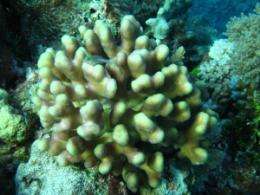Limited iron availability shown to exacerbate coral bleaching

(PhysOrg.com) -- It is widely held that coral bleaching occurs when temperatures and solar radiation are high, overwhelming antioxidant defenses in the algal endosymbionts and their coral hosts. Little understood are the biological mechanisms underlying such destabilization under stressful conditions.
An international research team led by marine biologist Malcolm Shick and chemical oceanographer Mark Wells of the University of Maine School of Marine Sciences studied the symbiotic coral Stylophora pistillata from the Great Barrier Reef to fathom the role of iron limitation on coral bleaching. Iron and other trace metals are essential for photosynthesis, antioxidant defenses and other metabolic processes.
Their study is the first to demonstrate that limited iron availability exacerbated the high-temperature stress in S. pistillataby decreasing its photosynthetic efficiency and antioxidant defenses.
The implication is that the degree of coral stress in natural environments under high light and temperature may be modulated by trace-metal nutrition.
The findings of the research team, which included scientists from the University of Western Ontario and the Australian Institute of Marine Science, were published in the journal Limnology and Oceanography.
Provided by University of Maine


















